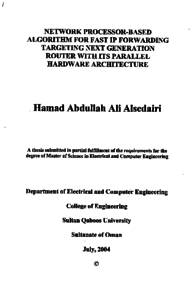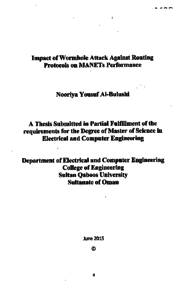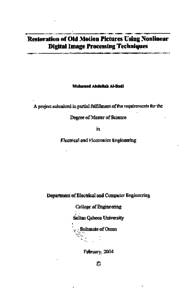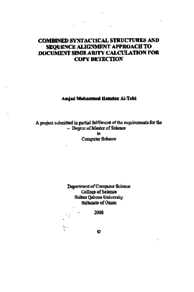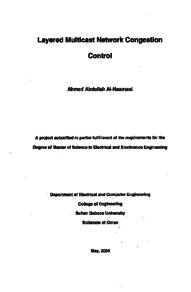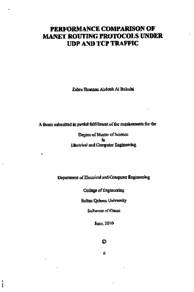Document
Network processor-based algorithm for fast IP forwarding targeting next generation router with its parallel hardware architecture.
Publisher
Sultan Qaboos University
Gregorian
2004
Language
English
Subject
English abstract
Recent developments in communication link speeds, to meet the traffic requirements of the continuing evolution applications and network services being used, places increasing demands on the performance of routers. The Internet Protocol (IP) routers primary function is to determine the longest matching prefix, at the routing database lookup table for the next-hop, compared to the incoming packet's P destination address. The packet is then forwarded to the output link associated with that prefix, directed to the next router or the destination host. Therefore, with the increased traffic, higher speed links, increasing routing table sizes, migration from 32 bits IPv4 to 128 bits IPv6 addresses, and more demand for faster and efficient IP address lookups, a significant performance bottlenecks has been placed on the routers. Consequently, an industry's efficient, scalable, flexible and cost-effective solution for these challenges is a specialized processor called Network processor, which provides performance at hardware speeds while attaining the flexibility of software. In this work, it has been demonstrated that by adequately combining hardware and software features of the networking algorithms, a high performance can be achieved by the router. A proposed IP forwarding algorithm codes, for calculating the longest matching prefix, requires 902 computing cycles in sequential execution and 271 cycles only using parallel multithreading execution. Also, a proposed hardware of a router, based on the IXP1200 Network Processor along with two 1Gbps Interface Cards, 8Mbytes SRAM and 256Mbytes SDRAM, can handle 0.25Mpps of a 1024Bytes packet size at 2Gbps data rate line speed. A modified router hardware consisting of five DXP1200 Network Processor, five DRAM banks of 256Mbytes each (total of 1.28Gbytes), five SRAM banks of 8Mbytes each (total of 40Mbytes), and ten Interface Cards of 1Gbps each, scales to achieve 1.25Mpps with 10Gbps OC192 data rate.
Member of
Resource URL
Arabic abstract
أدت التطورات الحديثة في خطوط الإتصال واللازمة لتوفير سرعات مرتفعة للتطبيقات وخدمات الشبكة ذات التطور المستمر أدت إلى زيادة الطلب على موجهات عالية الكفاءة. ويعتبر تحديد أطول بادئة متطابقة في قاعدة بيانات التوجيه (جدول البحث المحطة التالية بمقارنة العنوان المستهدف و الموجود في الرزمة الواردة، يعتبر المهمة الرئيسية الموجهات برتوكول الإنترنت. حيث يتم بعد ذلك تحويل الرزمة إلى وصلة الإخراج المتوافقة مع البادئة المحددة. و بذلك يتم إرسال الرزمة إلى الموجه التالي أو الجهاز المستهدف. لذا و مع زيادة الرزم المتحركة، وزيادة سرعات الروابط ، و زيادة أحجام جداول التوجيه، و التحول من بتات عدد ۳۲ في النسخة الرابعة إلى بنات عدد ۱۲۸ في النسخة السادسة لبرتوكول الشبكة (IP) ، و زيادة الطلب على قدرات عالية السرعة و الكفاءة للبحث في جداول التوجيه، كل ذلك أدى إلى إعاقة أداء الموجهات. بالتالي، أوجدت هذه التحديات حلا يتسم بالكفاءة و المرونة و الفاعلية وذي قدرات تطويرية و كذلك إقتصادي. و قد سمي هذا المنتج بالمعالج الشبكي حيث يجمع بين كفاءة العتاد و مرونة البرمجيات. وقد خلص هذا المشروع إلى أن إستخدام العتاد و البرمجيات ذات الصفات الملائمة الخوارزميات الشبكات يعطي الموجهات قدرات و كفاءات عالية. حيث يحتوي البرنامج المقترح على عدة خطوات لتحديد أطول بادئة متطابقة، و يحتاج إلى ۹۰۲ وحدة تنفيذية عند تطبيقه تعاقبيا و ۲۷۱ وحدة فقط عند تطبيقه على التوازي. أما العتاد المقترح للموجه فقد إحتوي على معالج شبكي من شركة أنتل من نوع (IXP1200) و كذلك على بطاقتي شبكة سرعة كل واحدة مليار بت في الثانية. ويحوي الموجه كذلك ۸ مليون بایت و ۲۰۹ مليون بايت ذاكرة من نوع (SRAM) و (DRAM) على التوالي. يقوم الموجه بمعالجة ۰٫۲۰ مليون رزمة في الثانية بحجم ۱۰۲4 بايت للرزمة على خط معلومات سرعته ۲ ملیار بت في الثانية. وللحصول على سرعة قياسية من نوع (0C192) تم تعديل الموجه ليحوي عدد خمسة معالجات من نفس النوع المذكور، و كذلك خمس وحدات ذاكرة من نوع (DRAM) بسعة ۲۵۹ ملیون بایت الوحدة لتعطي ما مقداره ۱٫۲۸ ملیار بايت. يحوي الموجه كذلك خمس وحدات ذاكرة من نوع (SRAM) و بسعة 8 مليون بايت للوحدة لتعطي 40 مليون بايت. أما عدد بطاقات الشبكة في الموجه فقد بلغ عشر بطاقات سرعة الواحدة مليار بت في الثانية. حيث يقوم هذا الموجه بمعالجة 1٫۲۵ مليون رزمة في الثانية على خط معلومات سرعته عشرة مليارات بت في الثانية هي نفس السرعة القياسية من نوع (0C192) المستهدفة
Category
Theses and Dissertations

